
Elegant, fragrant, and unmistakably regal, lilies are some of the most adored flowers in the world. Whether they bloom in wedding bouquets, grow in gardens, or are placed in a heartfelt arrangement, lilies carry deep meaning and symbolism. The lily flower meaning goes far beyond just beauty—it speaks of purity, devotion, renewal, and timeless elegance.
In this article, we’ll explore the lily’s rich history, its spiritual and cultural symbolism, the meaning behind different colors, and how you can use lilies to express heartfelt emotions.
🌼 The Origin and History of Lilies
Lilies have an ancient and storied past. They are believed to have originated in parts of Asia and Europe, and they’ve been revered for thousands of years. In Greek mythology, lilies were said to have sprung from the milk of Hera, the queen of the gods, symbolizing divine beauty and femininity. In Christianity, the white lily (often called the Madonna Lily) symbolizes the Virgin Mary’s purity and is frequently used in religious art and ceremonies.
Over time, lilies have become beloved in many cultures for their visual impact and graceful presence.
🌸 General Symbolism of Lily Flowers
Across cultures and centuries, the lily flower meaning remains consistent and deeply touching. Here are the core values that lilies represent:
• Purity and Innocence: Especially white lilies, which are associated with spiritual purity and virtue.
• Grace and Elegance: Their symmetrical shape and gentle scent make them symbols of refined beauty.
• Renewal and Rebirth: Lilies often bloom in spring, symbolizing new beginnings and transformation.
• Devotion and Love: In funerals or romantic arrangements, lilies express love, admiration, and loyalty.
🎨 The Meaning of Lily Flower by Color
Just like roses or tulips, the meaning of lilies varies by color. Choosing the right hue adds depth to your message:
1. White Lilies
Symbolism: Purity, virtue, and peace
Perfect for: Weddings, baptisms, memorials
White lilies are the most iconic and are often used in religious and spiritual ceremonies.
2. Pink Lilies
Symbolism: Compassion, admiration, and femininity
Perfect for: Mother’s Day, birthdays, or a thank-you bouquet
Pink lilies carry a soft, nurturing vibe.
3. Red Lilies
Symbolism: Passion, love, and confidence
Perfect for: Romantic gestures or bold declarations of admiration
Red lilies are dramatic and captivating.
4. Orange Lilies
Symbolism: Enthusiasm, warmth, and energy
Perfect for: Celebrations or cheering someone up
They radiate positivity and boldness.
5. Yellow Lilies
Symbolism: Joy, gratitude, and friendship
Perfect for: Brightening someone’s day or saying thank you
They’re uplifting and cheerful.
6. Purple Lilies
Symbolism: Royalty, mystery, and pride
Perfect for: Elegant arrangements or expressing admiration
They bring a regal and sophisticated feel.
🌿 When to Give Lilies
Because of their versatile symbolism, lilies fit beautifully into many life events:
• Weddings: White lilies symbolize pure love and commitment.
• Funerals and Memorials: Lilies offer peace and comfort to grieving families.
• Mother’s Day: Pink or white lilies celebrate maternal love and grace.
• Anniversaries or Birthdays: Bright lilies like orange or yellow bring joyful energy.
Whether you want to honor a memory, celebrate love, or send a meaningful message, lilies always speak from the heart.
💡 Fun Fact: Lilies in Pop Culture
Lilies frequently appear in literature, poetry, and visual arts as symbols of beauty and the fleeting nature of life. You’ll find them in everything from ancient frescoes to modern tattoos—proof that the lily’s meaning continues to resonate across generations.
🌺 Final Thoughts
Whether you’re drawn to their stunning shape, soft fragrance, or spiritual symbolism, lilies are more than just beautiful flowers—they’re carriers of deep emotion. The lily flower meaning is timeless and universal: it speaks of grace, purity, and the powerful beauty of life’s most meaningful moments.
So the next time you’re choosing flowers for a wedding, funeral, celebration, or just to brighten someone’s day, consider the lily. It’s not only a bloom—it’s a heartfelt message in floral form.
